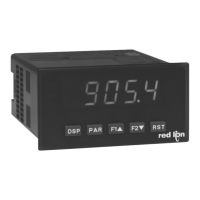25
Enter desired hysteresis value. See Setpoint Alarm Figures for visual
explanation of how setpoint alarm actions (balance and unbalance) are affected
by the hysteresis. Depending on the Setpoint Action, , the value may be
affected by the input rounding factor, . When the setpoint is a
control output, usually balance hysteresis is used. For alarm applications,
usually unbalanced hysteresis is used. For unbalanced hysteresis modes, the
hysteresis functions on the low side for high acting setpoints and functions on
the high side for low acting setpoints.
Note: Hysteresis eliminates output chatter at the switch point, while time delay
can be used to prevent false triggering during process transient events.
HYSTERESIS VALUE
to
to
SETPOINT VALUE
When , the alarm is disabled (after a power up) until the trigger point is
crossed. Once the alarm is on, the alarm operates normally per the Setpoint
Action and Reset Mode.
OFF TIME DELAY
ON TIME DELAY
to sec.
OUTPUT LOGIC
RESET ACTION
to sec.
STANDBY OPERATION
Enter desired setpoint alarm value. These setpoint values can also be entered
in the Display Mode during Program Lock-out when the setpoint is programmed
as in Parameter Module 3. Depending on the Setpoint Action, , the
value may be affected by the input rounding factor, . When a
setpoint is programmed as deviation or band acting, the associated output tracks
as it is changed. The value entered is the offset, or difference from .
Enter the time value in seconds that the alarm is delayed from turning on after
the trigger point is reached. A value of 0.0 allows the meter to update the alarm
status per the response time listed in the Specifications. When the output logic
is , this becomes off time delay. Any time accumulated at power-off resets
during power-up.
Enter the time value in seconds that the alarm is delayed from turning off after
the trigger point is reached. A value of 0.0 allows the meter to update the alarm
status per the response time listed in the Specifications. When the output logic
is , this becomes on time delay. Any time accumulated at power-off resets
during power-up.
Enter the output logic of the alarm output. The logic leaves the output
operation as normal. The logic reverses the output logic. In , the alarm
states in the Setpoint Alarm Figures are reversed.
Enter the reset action of the alarm output.
= Automatic action; This action allows the alarm output to automatically
reset off at the trigger points per the Setpoint Action shown in Setpoint Alarm
Figures. The “on” alarm may be manually reset (off) immediately by a front
panel function key or user input.The alarm remains reset off until the trigger
point is crossed again.
= Latch with immediate reset action; This action latches the alarm
output on at the trigger point per the Setpoint Action shown in Setpoint Alarm
Figures. Latch means that the alarm output can only be turned off by front
panel function key or user input manual reset, serial reset command or meter
power cycle. When the user input or function key is activated (momentary or
maintained), the corresponding “on” alarm output is reset immediately and
remains off until the trigger point is crossed again. (Previously latched alarms
will be off if power up Display Value is lower than setpoint value.)
= Latch with delay reset action; This action latches the alarm output
on at the trigger point per the Setpoint Action shown in Setpoint Alarm
Figures. Latch means that the alarm output can only be turned off by front
panel function key or user input manual reset, serial reset command or meter
power cycle. When the user input or function key is activated (momentary or
maintained), the meter delays the event until the corresponding “on” alarm
output crosses the trigger off point. (Previously latched alarms are off if
power up Display Value is lower than setpoint value. During a power cycle,
the meter erases a previous Latch 2 reset if it is not activated at power up.)
* Deviation and band action setpoints are relative to the value of setpoint 1.
It is not possible to configure setpoint 1 as deviation or band actions. It is
possible to use setpoint 1 for an absolute action, while its value is being used
for deviation or band.
** The lower Totalizer action allows setpoints to function off of the
lower 5 digits of the Totalizer. The upper Totalizer action allows
setpoints to function off of the upper 4 digits of the Totalizer. To obtain
absolute low alarms for the Totalizer, program the or output
logic as reverse.
Enter the action for the selected setpoint (alarm output). See Setpoint Alarm
Figures for a visual detail of each action.
SETPOINT ACTION
=
Absolute high, with balanced hysteresis
Absolute low, with balanced hysteresis
Absolute high, with unbalanced hysteresis
Absolute low, with unbalanced hysteresis
Deviation low, with unbalanced hysteresis *
=
Outside band, with unbalanced hysteresis *
Upper Totalizer absolute high, unbalance hysteresis**
=
=
=
=
=
=
=
=
Setpoint always off, (returns to SPSEL NO)
Deviation high, with unbalanced hysteresis *
Lower Totalizer absolute high, unbalance hysteresis**
SETPOINT SOURCE
Selects the meter input value to be used to trigger the Setpoint Alarm. The
setting will cause the setpoint to trigger off of the relative (net) input value.
The relative input value is the absolute input value that includes the Display
Offset Value. The setting will couse the setpoint to trigger off of the
absolute (gross) input value. The absolute input value is based on Module 1
and entries. This parameter is not available when is
or .

